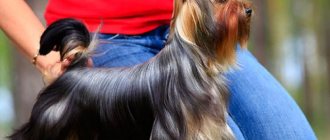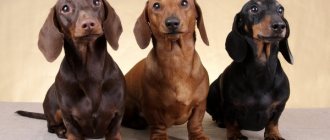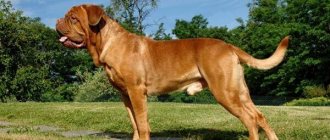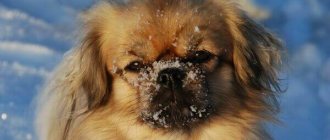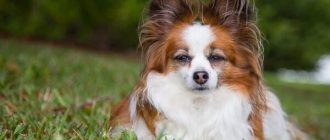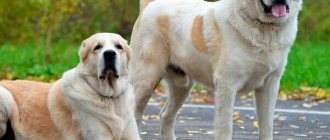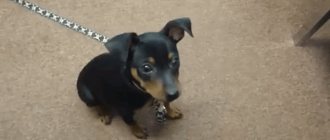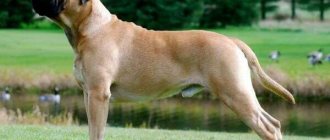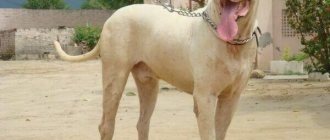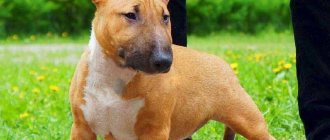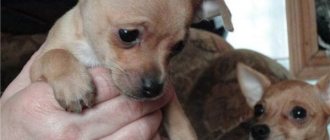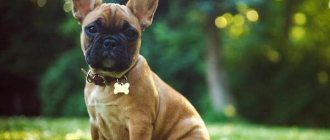The name of the miniature pinscher breed, which is difficult to pronounce, makes many people think. You won’t immediately remember what this dog looks like. Those who are familiar with the breed understand that this means a miniature pinscher or a mini Doberman. True, there is a distorted opinion about these dogs, since the animal is quite miniature in size. Everyone thinks that these miniature dogs are timid and stupid. Is it so?
What is the correct name of the breed?
The breed, which is often called the dwarf Doberman and mini Doberman, does not actually exist.
In the standard it is written as a miniature pinscher . But there is still some similarity with Dobermans, and it is explained by the fact that Karl Doberman developed his breed based on miniature pinschers.
Personality
The Mini Pinscher is famous for its intelligence, cheerfulness, positive outlook on life, courage and exceptional independence. By temperament, miniatures are typical sanguine people: calm, reasonable, self-confident.
These charming, compact dogs avoid excessive attention, excessive displays of feelings, and familiarity. Miniature pinschers are filled with self-esteem and noble aristocracy.
German selection created a breed strictly oriented towards one owner. Getting into the family as a very small puppy, the dwarf Doberman chooses a leader, firmly understands the “pack” hierarchy and perceives the rest of the world as the “hostile side of life,” potentially aggressive and dangerous. Protection of the pride territory, distrustful attitude towards strangers, unconditional protection of the owner and his property are the innate qualities of all German Pinschers. Compactness, deceptive fragility and decorativeness are easily misleading: the Miniature Pinscher impresses with its speed, strength and tirelessness. This is truly a miniature copy of the canon of “war dogs” Dobermans.
A description of the character Miniature Pinscher breed will be incomplete without mentioning the dominant aspirations of the pet. Like all German pinschers, miniature pinschers need decisive and fair leadership: the short-haired small breed obeys only a strong-willed, self-confident person. The little despot will instantly “raise” the owner with a weak character and occupy all the dominant heights.
Rash actions are out of the style of highly intelligent mini pinschers , but in order to correctly realize unbridled energy, the dog must constantly be busy with work. Regular training, sports activities, quality active walking and outdoor games are an excellent alternative to guard duty. The main principle of the German martinets: a warrior unloaded with official duties is a potential criminal.
Brief psychological characteristics of the miniature pinscher breed :
- courage and bravery;
- independence in decision making;
- suspicion and constant readiness for action;
- dynamism and endurance;
- territoriality;
- learning ability, obedience;
- multi-format sports (agility, freestyle);
- loudness and tendency to “voice.”
You need to clearly understand that the micro Doberman is not a decorative dog. With thoughtful, professional maintenance, the miniature pinscher demonstrates to the world all the qualities of an ideal service (police) dog.
Origin story and what it looks like in the photo
The first mentions of miniature pinschers date back to the 15th century . In Germany, in a city called Württemberg, like all cities of the Middle Ages, there was an acute problem with a large number of rats.
At that time, they were actively engaged in breeding a breed that could fight them.
It was on this basis that these dwarf dogs appeared. Also, the miniature pinscher was indispensable for hunting, this allowed him to become an almost universal dog.
The breed gained second popularity in the 20th century, but it has already begun to be adopted as a companion..
Owner reviews
Among all the reviews from dog breeders about various breeds of pinschers, one can highlight opinions about specific pets:
DarkAngel/2297 (Russia, Samara)
The Miniature Pinscher has been living in the house for several years now. It should be noted that this is a very affectionate and loyal friend who loves to be the center of attention. However, he is extremely active and problems arise during the training process.
Kaplya (Russia, Krasnodar)
A Doberman Pinscher lives in the house. We love this pet very much, but we can immediately say that dogs of this breed are not for every dog owner. Despite their positive qualities - short-haired, intelligent, graceful creatures quickly get used to their owner, they also have serious disadvantages. They can be vicious and love to dominate, so raising Dobermans can be quite difficult. But if you find an approach to the dog, it will become your best and most devoted friend.
In general, you can buy any variety of pinscher and never regret your choice - after all, these pets are so loyal and loving, and their maintenance and training will not be a burden even for novice dog breeders. And if the apartment is not too large, then you can buy a dwarf Pinscher or Affenpinscher, which do not take up much space, but will be the best and most loyal friends despite their small size.
Pet character
This is a very capricious breed that requires constant watch and control . This is a very jealous dog. He won't tolerate it if you stop giving him influence.
For the same reason, mini Dobermans are distrustful of strangers, especially if the owner is favorable to them.
Despite the fact that the dog is small, he will without hesitation defend his owner and the rest of the family. At the same time, the dog does not warn about its intentions and will always attack first.
For the same reason, you need to walk your dog on a leash to avoid any unpredictable moments..
Dog socialization should be done as early as possible. A dog that communicates with other relatives grows up calm, balanced and with high intelligence.
Expert opinion
Kozhevin Semyon Kirillovich
Expert dog handler.
“The dog is very self-confident and domineering, if its character is not suppressed, it will sit on the neck and very quickly. She needs someone with the same temperament next to her. She doesn’t like children, so you should always pay close attention to how your pet and your child play. Always attacks without warning and with aggression. But in general, if raised correctly, the dog will never offend without reason. He is always in the best mood towards his owner.”
Miniature Pinscher training
The breed is endowed with high learning abilities. During training, it is important to use love and affection, but not to spoil the puppy. The best time to start is 3 months of age. The first classes should be conducted in a playful way; if possible, it is important to adjust character traits. Lessons with animals must be built on two principles: sequence of actions and repetition.
To prevent the mini Doberman miniature pinscher from trying to take a leading position, the owner must be calm, self-confident and firm in his own intentions. The dog will quickly master the training apparatus; it will not be difficult for him to reach a height 5 times his height. The combination of abilities and high maneuverability make the breed one of the best, which demonstrate excellent results in agility.
Breed standard
| Part of the body | Description |
| General form | It is a smaller copy of the German Doberman Pinscher. He does not have all the disadvantages that mini breeds have. This is a graceful, smooth-haired dog whose body resembles a square. |
| Head | The skull is oblong, without an occipital protuberance. The forehead is flat, the transition from it to the muzzle is insignificant. Black nose, black lips adjacent to the jaw. Strong jaws and scissor bite. The eyes are dark and oval. Ears erect or hanging on cartilage. Triangular. |
| Neck | Graceful, smoothly curved, medium length. The base is not marked; it transitions smoothly to the withers. It has no dewlap and dewlap. |
| Frame | The topline is slightly sloping, with the withers forming the highest point of the topline. The back is strong and elastic. The croup is rounded, merging into the base of the tail. The chest is moderately wide, the sternum protrudes. The sides are not quite matched. The tail is not docked. It has a saber or crescent shape. |
| Limbs | The forelimbs are strong and not placed close together. The humerus bones fit tightly to the body. The forearms are straight, strongly developed. The front paws are elastic and strong, the toes are arched, the pads are elastic and black. The hind limbs are slightly set back. The thighs are moderately wide and very muscular. Hock joints with pronounced angles, metatarsus set vertically. The hind legs are slightly longer than the front legs. Fingers are closed, arched. Claws and pads are black. |
| Movements | The breed is a trotter. The back remains strong while moving. The dog moves effortlessly, smoothly and harmoniously with a typical free sweeping trot. |
| Leather | Must fit snugly around the entire body |
| Coat | The coat should be free of bald spots. Short, thick, shiny, also tightly fitting. |
Pomeranian Spitz
The first ancestors of the Pomeranian were twice as large and lived in the German province of Pomerania, where their name came from. At the end of the 19th century, the Spitz spread widely throughout Europe , where work began on developing a smaller breed with an improved exterior. On average, the height is 23-29 cm, weight is 2-4.5 kg, there are 11 colors of the Pomeranian Spitz.
They are active and cheerful by nature, they love to play and spend time with their owner . In the absence of proper upbringing, they try to dominate the family and become cocky. They often bark because they love to listen to their clear voice . Great for children and apartment living.
Advantages and disadvantages
Advantages:
- A small dog that can be kept even in small apartments and rooms, unlike the larger Doberman;
- Very good health, with minimal risk of hereditary defects;
- Very hardy and active, likes long walks;
- Hears well and has an excellent sense of smell;
- It has no undercoat, which means that a person with allergies can get such a dog;
- Short hair hardly sheds;
- There is no specific dog smell;
- They are not friendly in food, but it must be special due to their active lifestyle;
- Will become an excellent guard on its territory;
- They listen to the owner and learn quickly;
- Loyal and faithful to their person;
- They are calm with other pets and children;
- The breed can be litter trained.
Flaws:
- Hyperactivity may develop;
- Desperate bullies who will attack without hesitation;
- They bark loudly and shrilly;
- Very wary of strangers, no matter what relationship the owner has with them;
- They cannot stand loneliness. They take revenge for him by damaging things and furniture;
- They love long and active walks all year round. At least one trip outside per day is necessary;
- His favorite pastime is digging, because in the past dogs were rat catchers;
- During the cold season, you will need clothing;
- They are very cunning, you cannot show weakness around them;
- They love to manipulate the rest of the household.
Métis
Mixed breeds are puppies born from representatives of two different purebred dogs . The breeding of mestizos sometimes leads to the emergence of new breeds, and interbreeding is actively used by breeders. However, this can lead to both good and bad results, and inexperienced people should not experiment with animal genetics.
Rottweiler mix
Mixed breeds are stockier, have the same coloring and are very similar in appearance to both Rottweilers and Doberman Pinschers. Traits are inherited as follows:
- Puppies get their body exterior mainly from Doberman Pinschers;
- the exterior of the head is from Rottweilers.
Character traits are inherited equally from both parents, but puppies require training. In general, they make brave guard animals .
With a shepherd
There is a separate name for puppies born from a Doberman and a German Shepherd - Berger. This mixture of blood produces good guard dogs that require careful training, otherwise they will grow up irritable and very aggressive. In childhood, these are playful puppies, prone to biting, which must be stopped, since the animal quickly loses control over the force of the bite.
In appearance, Bergers resemble a Doberman, inheriting the color of a shepherd dog . These are tall slender dogs with a pointed muzzle and high erect ears. The limbs are long and powerful, with wide paws.
With a pit bull
A very dangerous mixture of blood, since the puppies inherit the famous death grip from the pit bull. The color and structure of the muzzle are very similar to those of pit bulls, and the slender legs and long body are inherited from the second parent. Sometimes puppies get the coloring characteristic of Doberman Pinschers.
These mixed breeds make good guard dogs , but puppies need training to avoid excessive activity and aggression. They have their own name - Canis panther.
With a mongrel
It is very difficult to guess the character and appearance of a Doberman mixed breed with mongrels - it all depends on the second parent, his blood, appearance and character. In general, animals usually turn out to be strong, with good immunity, and are distinguished by loyalty and good obedience if properly raised. Externally, the animals are usually tall and strong.
Other famous hybrids
- A cross between a Doberman and a black Great Dane - in appearance the dogs are absolutely black, tall, with an exterior closer to a Doberman, but very tall.
- Doberman and Labrador mixes are large dogs with the appearance of a Doberman and the muzzle characteristic of a Labrador.
- A cross with a Siberian Husky, they are short, powerful animals with short hair and the characteristic color of a Doberman.
Size, weight and other distinctive features
For females and males, height is 25-30 cm and weight 4-6 kg.
Weight is the main characteristic of the mini Doberman. Due to its excessive activity, the dog can be too thin, and if the diet is chosen incorrectly, it can become obese.
NOTE!
The following are also uncharacteristic of dogs: cowardice, unreasonable aggression, obvious distrust or nervousness.
Also pay attention to height - it should not exceed standard values by more than 2 cm.
Miniature Pinscher
- Height: from 25 to 30 cm
- Weight: from 3.5 to 5 kg
- Life expectancy: about 15 years
- Temperament: smart, playful, confident, responsive, friendly, energetic, independent, active
This is one of the most active dog breeds. Miniature pinschers are always on the move. This is good if you like activity and fun; this is bad if you like peace and quiet. Most miniature pinschers burn off most of their energy playing indoors and do not require much space to exercise.
Slender and graceful yet strong, the Miniature Pinscher is, in fact, one of the tallest miniature dogs . However, the weight is relatively small - from 4 to 5 kilograms. The coat is short and smooth.
Fun fact: the Miniature Pinscher is not a Miniature Doberman Pinscher. Although they both come from Germany, that's where their connection ends. The Miniature Pinscher is a unique breed, likely the result of crossing a German Pinscher, a Small Shorthair Terrier, a Dachshund and an Italian Greyhound.
The miniature pinscher is a perpetual motion machine. These cheeky, curious and agile dogs are always ready to play. They have been dubbed the “King of Toys” not only because of their majestic appearance and size, but also because they love toys. A person who shares his life with a miniature pinscher is never bored.
WARNING! True to their terrier heritage, these dogs can be harsh with other dogs and enjoy the opportunity to play hunter. Miniature Pinschers can be so engrossed in what they are doing that they will ignore your commands. Some would even call them stubborn. This is not a breed that can be safely let off a leash.
Popular colors
The breed standard only recognizes 2 colors for the Miniature Pinscher:
- Black and Tan . Markings should be on the inside of the ears, eyebrows, muzzle, chest, throat, pasterns, paws, on the inside of the hind legs, under the base of the tail.
- Ginger . This is a solid color that covers the dog's entire body.
Previously, there was also a brown and tan color, but today such dogs are bred only in the USA.
American Toy Fox Terrier
The breed was developed in the USA in the late 19th and early 20th centuries based on small fox terriers with smooth coats. The height of the American Toy Fox Terrier varies from 21 to 29 cm, weight from 1.5 to 3.5. The dog is athletically built and has no defects inherent in decorative breeds. He is hyperactive , easily masters new commands and is involved in any kind of dog sports . Toy Fox Terriers are smart, dexterous and brave, cheerful and friendly, and get along well with children and pets.
What diseases are they susceptible to?
Despite their excellent character, there are diseases that can still occur in miniature pinschers:
- Eye diseases (cataracts, glaucoma, entropion, corneal dystrophy);
- Diabetes mellitus and urolithiasis;
- Joint problems (shoulder dislocation, Perthes disease);
- Obesity;
- Pancreatitis.
Do not try to treat your dog yourself, especially with human medicine.
Russian toy terrier
The short-haired breed was bred in the USSR back in the 50s , but received recognition from the FCI only in 2022. Despite this, the kids, whose weight never exceeds 3 kg, are loved by our compatriots.
The Russian Toy Terrier is distinguished by emotional lability and instability of character ; without feeling its size, it bravely enters into battle with large animals. They require the attention of the owner, as they become very attached to him, but they get along quite poorly with other animals. They are trainable, but do not tolerate authoritarianism ; the owner needs to be patient and persevering in order to achieve results.
Care and maintenance
Caring for a dog is not difficult at all, it will only take a lot of time at first, and then you will get into the rhythm:
- You should walk your dogs at least once a day. The average duration of the walk should be 30 minutes;
- Prefer a harness over a leash. This will make walks more comfortable for the dog;
- Brush your pet 2 times a week. Be careful which comb you choose: it should not injure the animal;
- Mini Dobermans need to be bathed when they get dirty. On average this is 1 time per month;
- Wipe your pet's eyes 1-2 times a week. This can be done with a special lotion or chamomile decoction;
- You need to clean your ears once a week;
- Inspect your pet's teeth, make sure that tartar does not appear. To avoid this disease, brush them 1-2 times a week with a brush and a special paste or give them special treats;
- Trim your claws as they grow;
- After each walk, inspect the paw pads. Make sure there are no wounds, cracks or calluses;
- Vaccinate, worm, and treat fur against fleas and ticks in a timely manner.
Summing up
A small Doberman dog is an ideal choice for active, cheerful people who are ready to spend a lot of time with the dog (walking, playing, training). The characteristics of the miniature pinscher breed state: a well-bred pet will easily become a full member of the family. The main thing to remember is that miniature pinschers are not decorative dogs. Miniature Pinschers are dogs with excellent working parameters.
- Pinscher
- miniature pinscher
If you find an error, please select a piece of text and press Ctrl + Enter.
What is the difference between mini Dobermans and Dobermans
Dobermans and mini Dobermans are very different from each other. Their similarity lies only in appearance - similar color, and miniature pinschers sometimes have their ears cropped.
Otherwise, they are very different: miniature pinschers do not have their tail docked , they are more aggressive, their hunting instinct is better developed, and they are more often disobedient .
And in general, these two breeds have different areas of activity: Dobermans are good at military service and its varieties, and mini-Dobermans are companion dogs and hunter’s assistants.
Varieties
In total, there are 5 breeds bred on the basis of the Pinscher, each of which should be discussed separately:
- Miniature Pinscher - the smallest of all Pinschers. He has strong limbs, a powerful body with well-developed muscles. The fur is short, its color (according to the standard) can be red or black. According to the standard, these miniature dogs must have their ears and tail docked.
- Doberman is a pet of average height, its height at the withers usually does not exceed 0.5 m. This breed was developed by Friedrich Doberman (that is why this breed was named in his honor). These dogs are service dogs, they have a well-developed sense of smell, they are hardy, intelligent and at the same time very elegant. They are considered quite aggressive.
- German pinscher - a dog with an athletic build. His ears are high and erect, his muzzle is elongated. These dogs are smooth-haired; according to the standard, the color can be black or red.
- Australian Pinscher - A herding dog in the past, Australian farmers used these pinschers to help guard herds of sheep, as well as to catch rats and other small rodents. The fur is long and can have different colors.
- Affenpinscher – miniature pinschers, similar to primates (hence the name of the breed). The main feature of his appearance is his fluffy beard. These pinschers have floppy ears and very expressive eyes.
Proper feeding
Proper nutrition is very important for this breed. The choice of food depends on the owner, but it must be balanced and healthy.
IMPORTANT!
Up to 4 months, puppies need to be fed 6 times a day, and after this age, gradually reduce the number of feedings so that by the age of one year they are 2 times a day.
Miniature pinschers have very weak digestion, so make a choice - dry or natural food, but do not combine.
The menu should include the following products:
- Meat should always predominate; chicken or turkey is suitable for poultry;
- Fruits should also be given: pear, apple, banana, dried apricots as a treat;
- Boiled egg once a week;
- You can give fish, but only sea fish and no more than once a week;
- By-products can diversify your pet's menu: liver, heart, lung, tongue;
- Give fermented milk products - cottage cheese and low-fat kefir;
- Buckwheat and rice are suitable cereals;
- Miniature pinschers benefit from goat's milk;
- Vegetables should not be excluded either - carrots, cauliflower, broccoli, pumpkin;
- Always make sure the water in the bowl is fresh.
Prohibited foods include: white cabbage, river fish, bones, semolina, baked goods, sweets, smoked foods, sausages, citrus fruits, fatty meat, cow's milk, as well as all food from the human table.
Nurseries
Purchasing high-quality miniature pinscher puppies is advisable only in nurseries. The babies are accompanied by appropriate documentation indicating vaccinations and other necessary information.
When choosing a miniature pinscher puppy, you should keep in mind that healthy babies are characterized by activity, curiosity and a good appetite.
During the game, you can study the character of miniature pinscher puppies and make your choice. One will behave calmly, the second will show activity, the third will show aggression.
Parents of miniature pinschers should not be left without attention. As a rule, only a healthy dog gives birth to healthy children.
There are a sufficient number of nurseries in Russia where you can choose the miniature pinscher you like most: VANDEBOR (Moscow), Anlit Rilance (St. Petersburg), Pearl of the East (Vladivostok), Irhouse (Arkhangelsk) and others.
How to choose a puppy
First of all, you need to focus on the standard, although this is still difficult to do with puppies.
Ask to look at the parents and their documents, so you can be sure that the puppies really belong to this breed. Choose active, friendly, but not aggressive or cowardly ones.
The dog should not have external defects - lameness, malocclusion, different lengths of limbs . He should look and act like a healthy puppy.
The mucous membranes should be clean, there should be no unpleasant odor from the mouth and ears.
The coat should be free of bald spots, fleas and ticks. The puppy's appetite should be healthy, and the presence of any parasites in the feces is not allowed.
German pinscher
- Height: from 43 to 51 cm
- Weight: from 11 to 20 kg
- Life expectancy: 12 to 14 years
- Temperament: smart, loving, lively, balanced, energetic
The German Pinscher is not a smaller version of the Doberman Pinscher, the breed has a much longer history. It was used as an all-purpose farm dog and rat catcher, but the breed almost disappeared after World War II and was only brought back with the help of its descendant, the Miniature Pinscher. Today the German Pinscher is primarily a family companion and show dog.
If you are looking for a medium-sized dog that is bold, territorial and alert, you may want to consider the German Pinscher. This is a reliable friend and adventure partner with almost limitless energy . However, he will be a good choice for you only if you have leadership qualities. The German Pinscher is very assertive, decisive and manipulative; he will run your home if you let him.
Did you know that this German dog breed is considered the oldest of all Pinscher breeds, having given rise to dogs such as the Doberman Pinscher, Miniature Pinscher, Affenpinscher, Miniature Schnauzer, Giant Schnauzer and Standard Schnauzer. They were first mentioned in books dating back to 1884, where they were called smooth-haired pinschers.
With their smooth, shiny coat and neat, muscular body, German Pinschers look regal and confident. This breed's short, dense coat comes in a variety of colors, including black, brown, fawn and tan. Blue German Pinschers are rare , but some dogs have black fur with a blue tint.
Although every dog is different, in general the German Pinscher has a bold and curious personality. German Pinschers require a lot of exercise. They enjoy walking, hiking, jogging with their owners, and chasing balls and frisbees.
This breed is incredibly affectionate with members of the human family and is relatively open to meeting new people. German Pinschers are also quite tolerant of children and other dogs. They enjoy being an active part of the family and participating in daily activities and activities.
Havanese Bichon
The Havanese Bichon is the national dog of Cuba . To breed them, the now extinct ancestors of the Bichon were crossed with other varieties of lapdogs. The weight of such a dog is 3-5.5 kg, height 21-29 cm. Havanese are very socialized , they cannot be left alone at home, they are sociable and friendly. They perceive training as a game and enjoy learning new skills . They get along with other pets, and it doesn’t matter whether they grew up together or are seeing them for the first time.
Pekingese
The history of the breed goes back more than 4 thousand years; it originated in China . At that time, only members of the imperial family were allowed to own Pekingese; according to legend, the animals protected their owner from otherworldly evil forces. During the war, in the 1860s, the British took several individuals of the breed from Beijing, and, preserving their traditions, the Chinese began to destroy their pets; the Pekingese were on the verge of extinction . But thanks to the rapid spread in Europe, these babies were saved.
Having royal origins, the Pekingese requires proper treatment and respect . He is very jealous and does not intend to share his owner with other animals. He has a calm character, does not like noise and fuss , preferring a measured life and short walks. The maximum dimensions of the animal reach 5.5 kg and 25 cm at the withers.
Chinese Crested
Little is known about the breeding of the Chinese crested cat; it is believed to have originated in Africa or Mexico . In 1966, there were only a few specimens of the breed brought to the UK; thanks to the breeders, the breed was preserved and is now widespread. Representatives of the Chinese Crested come in two types : hairless (naked) and downy, but they are all united by character and size. The dogs reach 23-33 cm in height and weigh 2-5.5 kg.
This is an exclusively decorative dog , intended to become a devoted companion and a favorite of the public, thanks to its exotic appearance . He gets very bored alone and needs constant accompaniment from his owner. The Chinese Crested is friendly and curious, does not show aggression and is trainable.
